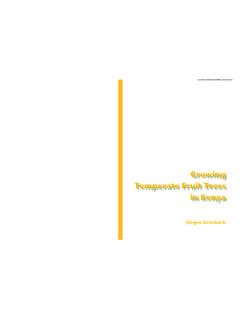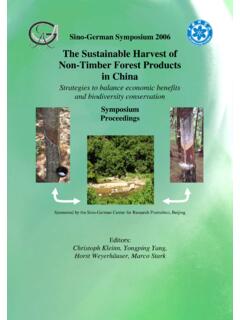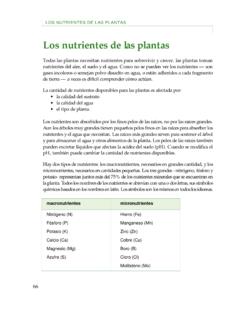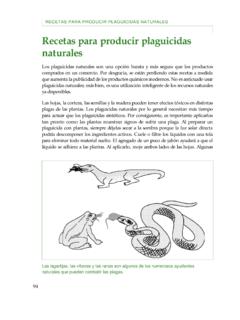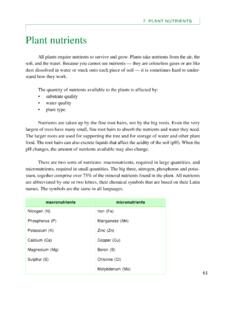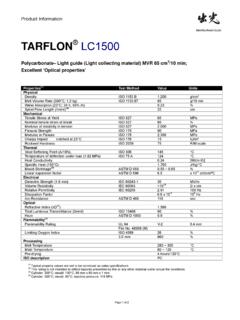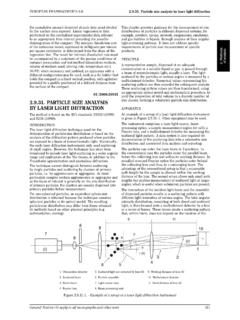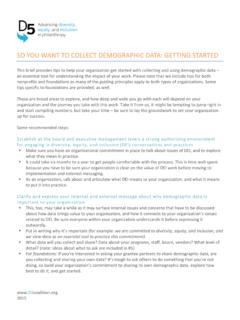Transcription of A Simple Guide on Good Nursery Practices final
1 good Nursery Practices : A Simple Guide Anne Mbora Jens-Peter Barnekov Lilles . Ramni Jamnadass About the World Agroforestry Centre The World Agroforestry Centre is a non-profit research organisation whose vision is a rural transformation in the developing world resulting in a massive increase in the use of trees in rural landscapes by smallholder households for improved food security, nutrition, income, health, shelter, energy and environmental sustainability. We are one of the 15 centres of the Consultative Group on International Agricultural Research (CGIAR). Headquartered in Nairobi, Kenya, we operate five regional offices located in Brazil, Cameroon, Indonesia, Kenya, and Malawi, and conduct research in eighteen other countries around the developing world. We receive our funding from over 50 different governments, private foundations, international organisations and regional development banks.
2 The World Agroforestry Centre, United Nations Avenue, Gigiri, PO Box 30677-00100, Nairobi, Kenya. Tel: (+254 20) 722 4000, Fax: (+254 20) 722 4001; Email: Web address: i good Nursery Practices : A Simple Guide 1. Anne Mbora, 2 Jens-Peter Barnekov Lilles & 1 Ramni Jamnadass 1. World Agroforestry Centre (ICRAF) P. O. Box 30677, GPO 00100, Nairobi, Kenya, Tel: + , email: 2. Forest & Landscape Denmark, Faculty of life sciences, University of Copenhagen, Horsholm Kongevej 11 DK-2970 Horholm, Denmark . Tel +4535331500, email: 1. World Agroforestry Centre (ICRAF) P. O. Box 30677, GPO 00100, Nairobi, Kenya, Tel: + , ii Citation: Mbora A., Lilles J-PB., Jamnadass R. 2008. good Nursery Practices : A Simple Guide . Nairobi. The World Agroforestry Centre. 36 pp. ISBN: 978-92-9059-235-8.
3 Cover photo: Kisiwa primary school tree Nursery and the students who take care of the Nursery in Kenya. Back photo: Participants at an ICRAF workshop visiting a Kenya Agriculture Research Institute tree Nursery . This publication may be quoted or reproduced without charge, if the source is acknowledged. iii Acknowledgements Our thanks to Ian Dawson for commenting on an earlier draft version of this Guide , and other colleagues at ICRAF Jonathan Muriuki for his invaluable support in the preparation of zero draft, Reagan Sirengo and Alexious Nzisa Mutua for helping in design and layout of this document iv Table of Contents Introduction .. 1. Establishing a tree 2. Nursery Site preparation .. 3. Nursery 3. Seedling 14. Principles of plant 15. Field planting-planting 22.
4 V Introduction Agroforestry plays an important role in the socio economic development of communities, as trees planted on farms provide timber, fuelwood, fodder, fruits, medicine, windbreaks, and a whole range of other economic and environmental benefits. At present the need to plant trees on farms is on the increase. It is difficult, however, for smallholders to access at the right time, in the right quantities and of high quality the trees that they want to plant. In order to meet present and future demand for planting material, there is a need to promote on-farm and community tree nurseries. Such nurseries can be owned and managed by individual farmers, by self-help groups, by schools, by churches and/or by a range of other local institutions. They provide income-generating opportunities, act as models for further Nursery development, provide seedlings more cheaply to planters, and can raise the particular species that local people are interested in.
5 In order for farmers and rural organisations to establish effective nurseries, it is important to provide Nursery managers with the Simple technical information they need for establishment and management of facilities. This is the role of this publication. 1. Establishing a tree Nursery Factors that influence location Where to site a Nursery is an important issue to consider before starting, because it influences the effort that will be required to maintain it, the way in which it will be managed, and the ease of access to users. Some of the factors to be considered in selecting the site for a Nursery include the following: There should be a reliable supply of water, ideally being near a river or ponds, or where a water tank or a drum to store water is available The site should be accessible all year round, so that customers are able to get seedlings easily, and so that Nursery staff can manage plants and transport mature seedlings to planting sites and/or markets good soils and other planting materials such as sand should be available easily The site should be protected from strong winds and from livestock, should receive sun, and should be on a gentle slope to allow drainage Factors that influence size How big a Nursery should be depends on many different factors, of which the following are most important: The space available for establishing the Nursery .
6 The land available on farms may only be small in area, but more space may be available in public land like school yards or church grounds Whether you will grow the seedlings in pots or in beds, and whether they will be raised from seed or from grafts, or from bare rooted cuttings, This will influence the amount of space each plant needs. Remember that in a Nursery additional space is required for keeping collected soil, sand and manure, and for mixing these materials The numbers of seedlings to be raised for personal use and for sale. When considering the size of the market for seedlings, it is better to start by being conservative in estimating what your market will be The amount of water that is available to maintain seedlings 2. Facilities and resources When establishing a Nursery , it is important to have somewhere to keep Nursery tools safely and in good conditions.
7 This does not have to be at the Nursery itself, but could be in the house, school, church or other location. The basic tools needed for a Nursery include jembes, pangas, shovels, empty tins with small holes in the bottom (to substitute for a watering can), and kitchen knives for root pruning. If resources allow, then proper watering cans, wheelbarrows, pruning knives, knife sharpeners, soil sieves and shovels are also all useful Nursery Site preparation When to start raising seedlings: The time to start work in the Nursery depends on when field planting is planned. It is important to allow sufficient time for seedlings to grow to a size where they will survive well in the field (normally 30 to 45 cm, though this depends on the species, where seedlings will be planted in farms, and how they will be managed).
8 The initial labour needed to establish a Nursery in bed construction, soil collection, fencing, the procurement of tools, etc. can take considerable effort but can be done some time in advance of raising seedlings. The sourcing of seeds or rootstocks that will be used to establish Nursery plants (see below) will also often need to be done in advance. Soil collection: The soil used to raise seedlings should be fertile and should drain well. Once a suitable collection site has been identified, clear the surface of weeds, leaves and other litter, then dig out the topsoil to a depth of about 10 cm deep. Remove any stones and roots, ideally be sieving. Then mix 2 parts of soil with 1 part of manure or compost and 1 part of sand (if available). Nursery operations Tree Nursery operations involves various activities such as, seed sourcing, Seed bed preparation, Sowing seeds, Potting, Pricking Out, Shading, Watering, Weeding, root pruning, application of additional fertilizers or manure 3.
9 Sourcing seed and pre-treatments Sourcing tree seed: It is important to try and use good quality seed in planting. Seed can be collected from trees locally from farms, forest or public land as long as one collects from at least more the 30 trees or can be bought from suppliers. It is a good idea to collect seed with neighbours; then bulk this seed together and share it out. In this way, diversity is maintained in planted material, which is important in promoting good performance. When getting seed from a supplier, it is important to look at the seed and check that it appears to be of good quality, and hasn't been collected too early (is immature) or contains many empty seed. Before planting a lot of seed, it is a good idea to first check it's viability by seeing if it germinates well.
10 Once you have an idea about viability, then it will be possible to estimate how many seed need to be planted to get a certain number of trees (for example, how many seed to plant in an individual pot). Seeds can be bought from local seed dealers, from NGOs, and from institutions such as KEFRI and the Forest Department. More information on how to source seed can be obtained by getting in contact with your local seed centre, or by reading resources like ICRAF's Tree Seeds for Farmers Toolkit (referenced at the end of this Guide ). Pre-treating seed: Sometimes it is important to treat seed before it is planted, in order to improve on the level, speed and uniformity of germination. These treatment methods can be used when seed does not otherwise germinate well. The most common methods for pre-treatment are: (a) Soaking seed in hot water until the seeds look swollen.

